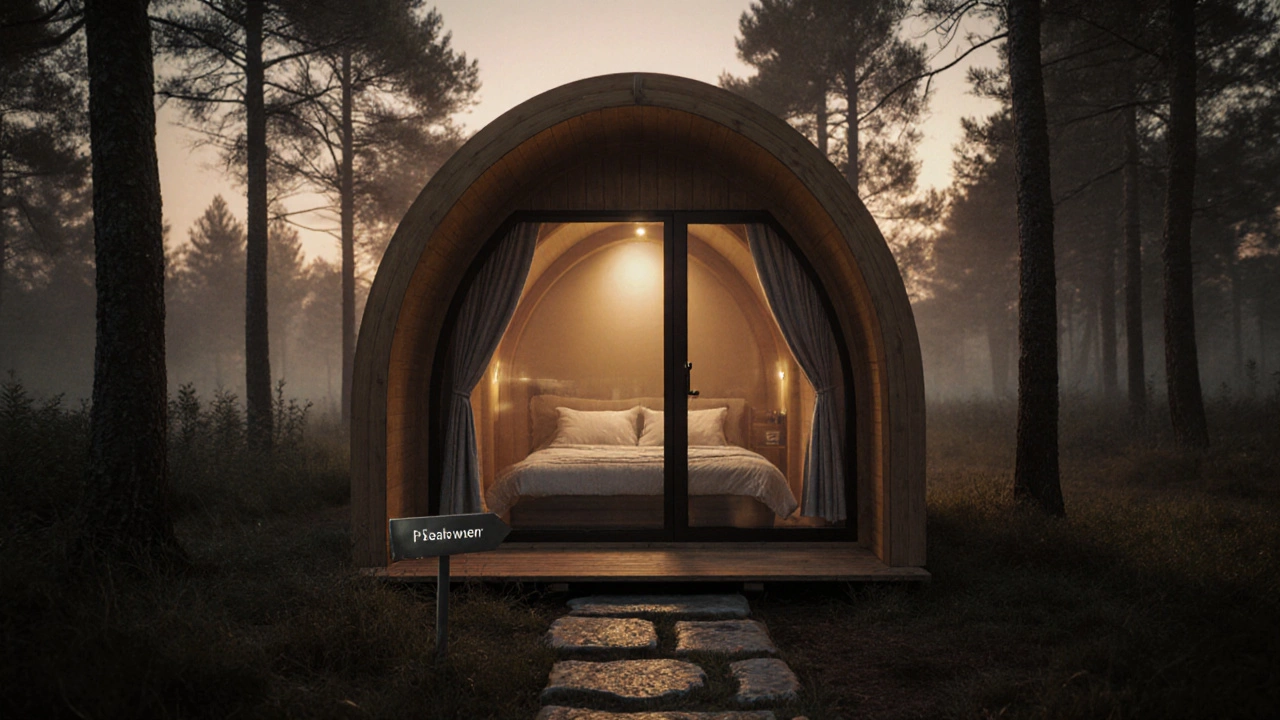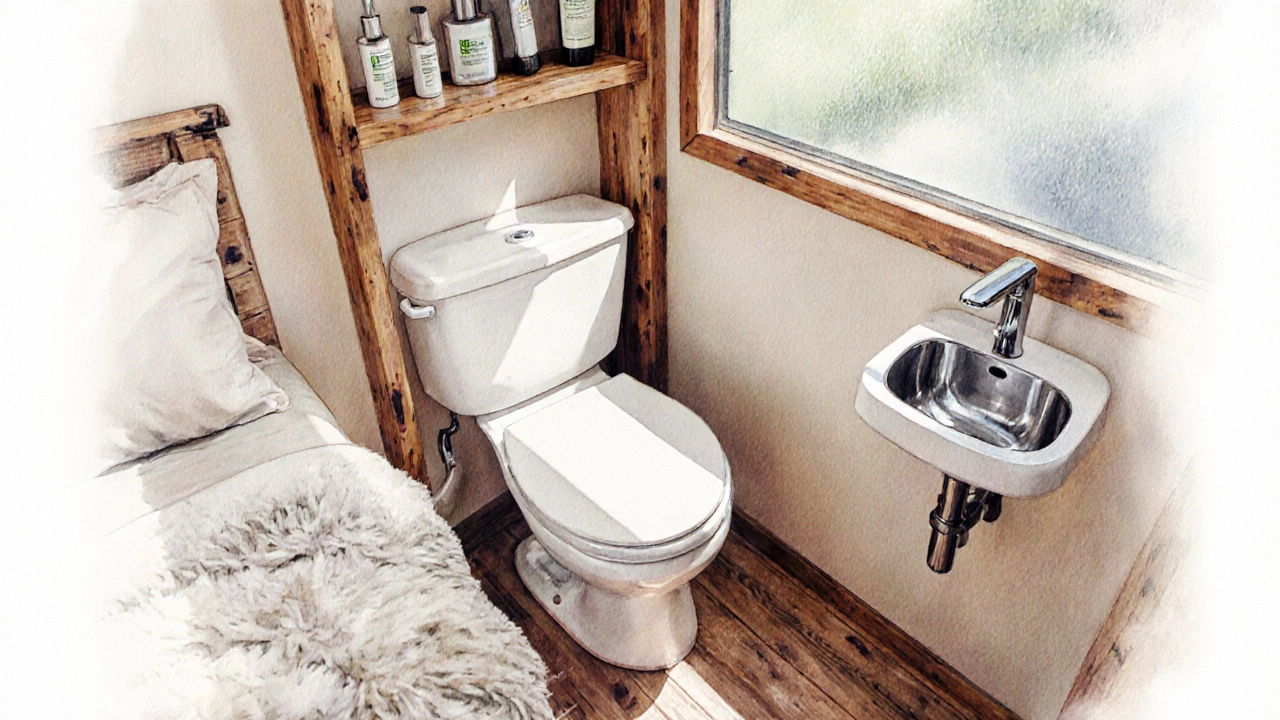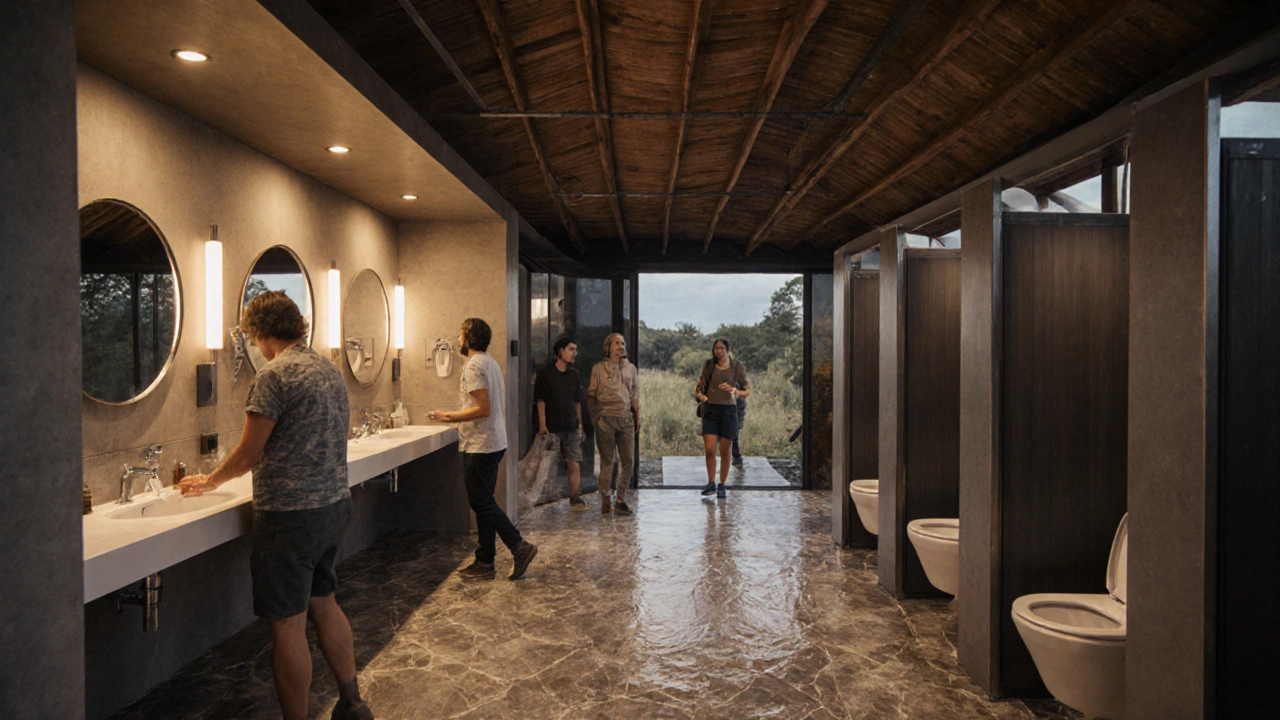Do Glamping Pods Have Toilets? Everything You Need to Know

Glamping Pod Toilet Checker
Check what toilet system you can expect at your glamping pod. Select your options below to see the typical setup for each configuration.
When you select your options above, the toilet system configuration for your glamping pod will appear here.
When you book a glamping pod is a compact, often eco‑friendly accommodation unit designed for "glamorous camping," typically featuring an insulated shell, ready‑made bed, and minimal interior fittings. One of the first things travelers wonder about is whether it comes with a toilet.
Most travelers wonder if glamping pods have toilets built in. The short answer is: it depends. Some pods ship with a private flush system, others rely on composting or portable solutions, and a few simply share a communal bathroom with neighboring units. Below we break down the most common configurations, the pros and cons of each, and how you can verify the setup before you book.
Typical Toilet Configurations Found in Glamping Pods
- Private Flush Toilet - a small, water‑based toilet connected to a septic or gray‑water system.
- Composting Toilet - a dry system that turns waste into compost, often used for off‑grid sites.
- Portable (Chemical) Toilet - a sealed container with chemicals that neutralize odors; emptied by the operator.
- Shared Bathroom - a communal facility that serves several pods, similar to a hostel’s bathroom.
Private Flush Toilets: Comfort Meets Convenience
Private flush toilets are the most hotel‑like option. They connect to a water line and a waste‑treatment system, offering a familiar flushing experience. Many upscale glamping resorts in Europe and North America install them because they meet guest expectations for hygiene and privacy.
Pros:
- Familiar operation (flush, water‑based cleaning).
- High perceived cleanliness.
- Often includes a small sink, enhancing convenience.
Cons:
- Higher installation cost - typically $2,500‑$4,000 per pod.
- Requires a reliable water source and septic permit.
- May increase the pod’s carbon footprint.
Composting Toilets: Eco‑Friendly but Requires Care
Composting toilets are popular for off‑grid or environmentally focused sites. They use little to no water, separating liquid and solid waste to produce compost that can be safely disposed of or even used as fertilizer after proper treatment.
Pros:
- Zero water consumption - vital where water is scarce.
- Lower long‑term operating costs; no sewer fees.
- Supports green‑certification goals.
Cons:
- Requires regular maintenance (adding bulking material, emptying chamber).
- May emit odor if not used correctly.
- Initial cost $1,200‑$2,500 per unit.

Portable (Chemical) Toilets: The Quick‑Fix Solution
Portable toilets, sometimes called “porta‑potties,” are the most common in pop‑up glamping festivals or seasonal sites that lack permanent infrastructure. They come pre‑filled with a chemical solution that suppresses odor and breaks down waste.
Pros:
- Easy to install - no plumbing needed.
- Low upfront cost (around $150‑$300 per unit).
- Can be moved or replaced quickly.
Cons:
- Limited usage per fill; typically 30‑50 uses before service.
- Less comfortable - no seat height adjustment, basic flushing.
- Perceived as low‑end by some travelers.
Shared Bathrooms: A Middle Ground
Shared bathrooms strike a balance between private installation costs and guest expectations. A cluster of pods may share a single bathroom block that includes multiple stalls and showers. This model is common in large glamping resorts that aim to keep prices reasonable while still offering indoor facilities.
Pros:
- Reduced per‑pod expense - the cost is spread across several units.
- Can include hot water showers, which many portable options lack.
- Better for compliance with local health regulations.
Cons:
- Potential wait times during peak morning hours.
- Less privacy compared to a private bathroom.
- Needs regular cleaning to maintain hygiene.
How to Verify Toilet Availability Before Booking
Because glamping pod setups vary widely, it’s essential to confirm the bathroom situation before you lock in a reservation. Here are three reliable steps:
- Check the official website. Look for a “Facilities” or “Accommodation Details” section. Brands that use private flush or composting systems usually list them explicitly.
- Read recent guest reviews. Platforms like TripAdvisor, Google, or niche glamping forums often mention whether the pod’s toilet was a highlight or a disappointment.
- Contact the host directly. A quick email asking, "Does the pod include a private toilet, or is it shared/portable?" gets a clear answer and shows the host’s responsiveness.
When you receive a vague answer, ask follow‑up questions about water source, waste disposal, and cleaning frequency. That small effort saves you from unpleasant surprises on arrival.
Cost Implications: What Your Wallet Might See
Toilet type can affect the nightly rate. A rough price breakdown from a 2024 industry survey of 150 glamping sites in North America shows:
| Toilet Type | Installation Cost (per pod) | Typical Nightly Rate Increase | Maintenance Frequency |
|---|---|---|---|
| Private Flush | $3,000-$4,500 | +$20-$35 | Monthly septic service |
| Composting | $1,500-$2,500 | +$10-$20 | Every 2-3 weeks chamber emptying |
| Portable (Chemical) | $200-$350 | No significant change | Every 5-7 days refill |
| Shared Bathroom | $5,000-$7,000 (for block) | +$15-$30 | Daily cleaning |
These figures are averages; exact costs vary by region, permit fees, and the luxury level of the glamping brand.

Regulations and Health Standards
Local health departments often dictate the minimum sanitation requirements for temporary accommodations. In Canada, for example, the Canadian Council of Ministers of the Environment (CCME) sets guidelines for waste water treatment and composting toilet certification. Failure to meet these standards can result in fines or closure.
In the United States, the National Park Service (NPS) advises that any glamping site operating within a national or state park must provide either a flush or approved composting system, with regular inspections.
If a site markets itself as "eco‑friendly" but relies solely on a portable chemical toilet, look for a statement about waste removal contracts and environmental impact assessments. Transparent operators will proudly share their compliance documents.
Tips for a Comfortable Bathroom Experience While Glamping
- Bring essential supplies. Pack toilet paper, hand sanitizer, and a small trash bag. Even if the pod includes a toilet, supplies may run low.
- Plan for limited water. With a composting or portable system, avoid flushing large amounts of paper. Use biodegradable wipes sparingly.
- Adopt a night‑time schedule. If you’re sharing a bathroom, a quick head‑count of other guests can help you avoid peak times.
- Ask about cleaning frequency. Knowing whether the host cleans the facilities twice daily or only once can set realistic expectations.
- Respect the environment. Follow any posted rules about waste disposal; improper use can harm the surrounding nature and penalties may apply.
Bottom Line: No One‑Size Answer
Whether a glamping pod has a toilet depends on its design, location, and the operator’s budget. Private flush toilets offer hotel‑like comfort but cost more, while composting and portable options prioritize sustainability and flexibility. Shared bathrooms give a compromise, especially for larger resorts.
Before you book, use the three‑step verification method, read recent reviews, and weigh the trade‑offs in cost versus convenience. Armed with this knowledge, you can pick a glamping pod that matches your comfort level and eco‑values without any nasty surprises.
Frequently Asked Questions
Do all glamping pods come with a private bathroom?
No. Some pods have private flush or composting toilets, while others rely on shared facilities or portable units. It varies by resort and region.
Are composting toilets sanitary enough for families?
Yes, when maintained correctly. They separate waste, use bulking material, and often have a vent to control odor. Regular emptying and proper use keep them clean and safe for kids.
How do I know if a portable toilet will be serviced during my stay?
Ask the host about their service schedule. Most reputable glamping sites empty or replace portable units every 3‑5 days, but it’s worth confirming to avoid unpleasant surprises.
Does a shared bathroom add extra cost to my booking?
Typically it adds a modest fee of $10‑$30 per night, reflecting the higher maintenance and cleaning requirements. Some resorts bundle the cost into the base rate.
What should I pack for bathroom hygiene while glamping?
Bring toilet paper, biodegradable wipes, hand sanitizer, a small trash bag, and a bottle of dish soap if you anticipate using a sink. A reusable water bottle helps if water is limited.